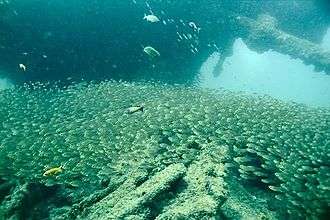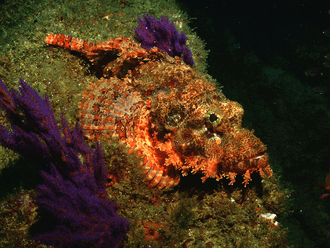Diving Aliwal Shoal/SS Nebo
Get in
Access
The site can only be accessed by boat. It is site is about 3 km from the launch site at the mouth of the Mkomazi River.
Position
S30°xx.xxx' E030°xx.xxx' This site is in a Marine Protected Area, requiring a permit for access.
Understand
Historical context
The SS Nemo was a 2000 ton single-propeller steam freighter on her maiden voyage from Sunderland, Britain to Durban, carrying 4500 tons of materials to build the Amanzimtoti railway bridge near Durban. As she neared Durban, official reports state that on May 20th 1884 she struck an unknown rock pinnacle. She was reportedly the third ship with the name 'Nebo', built by the same ship yard in Sunderland, that capsized on its maiden journey. No lives were lost during this incident. A different explanation for her demise is that a large wave caused her to overturn because of the heavy weight of the freight on deck. This is supported by the fact that she is lying upside down in the sand at a depth of 27 m, the wooden cross-members of the bridge dispersed underneath and around the wreck. The wreck was undiscovered for a long time until the 1960s when scuba divers found the wreck.
The hull of the ship has largely broken up, collapsed and dispersed, mainly due to heavy surge. However, parts of the stern can be identified, including the propeller and boiler.
Depth
20 m at the top of the upside-down hull, 27 m at the bottom on the sand.
Visibility

Underwater visibility is highly variable, due to the water from the Mkomazi River running into the sea close to the wreck. On a good day visibility can be 15 m.
Water Temperature
Around 22 degrees C.
Topography
Flat sandy bottom.
Conditions
The site is prone to spells of high sea current and/or bad visibility, especially when the Nkomazi River floods into the sea.
See

Marine life
The wreck houses large numbers of small fish, e.g. cardinals, sweepers and sea goldies. Game fish are frequently observed around the wreck, feeding on the smaller fish. The wreck also has many macro-organisms e.g. shrimps and multicoloured nudibranchs.
Features
Stern of ship is identifiable with rudder, propeller and boiler clearly visible.
Photography
This wreck is especially suited to macrophotography.
Suggested Routes
Stay safe
Hazards
The wreck of the Nebo frequently experiences strong sea currents to the North or to the South, when divers can easily be washed from the wreck. The visibility can be low when the Nkomazi River flows strongly into the sea after rains inland. This may require divers to swim in a tight group. On some days there is a significant surge that can cause divers to bump into sharp metal edges of the wreck.
Skills
This is a site more suited for advanced divers. Dives should be conducted in weak current conditions.
Equipment
Conventional recreational dive gear is sufficient to dive this site. A DSMB and reel is advantageous if a diver is washed off the wreck or if a diver surfaces far from the boat. A dive torch is recommended. Use of nitrox would significantly lengthen dive time.